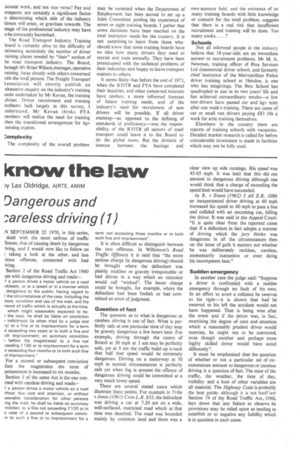know the law
Page 117

If you've noticed an error in this article please click here to report it so we can fix it.
)y Les Oldridge, AIRTE, AMIM
Dangerous and areless driving (1)
N SEPTEMBER 25 1970, in this series, dealt with the most seeious of traffic Tences, that of causing death by dangerous 'bring, and I would now like to follow on ( taking a look at the other, and less rious offences, connected with bad Section 2 of the Road Traffic Act 1960 als with dangerous driving and reads:– If a person drives a motor vehicle on a road cklessly, or at a speed or in a manner which dangerous to the public, haying regard to I the circumstances of the case. including the iture, condition and use of the road, and the nount of traffic which is actually at the time,
• which might reasonably expected to be, the road, he shall be liable on conviction
indictment lie when tried by a judge and ry) to a fine or to imprisonment for a term Lt exceeding two years or to both a fine and ich imprisonment; on summary conviction before the magistrates) to a fine not ceeding £100 or to imprisonment for a term Lt exceeding four months or to both such fine id imprisonment."
For a second or subsequent conviction fore the magistrates the term of iprisonment is increased to six months. Section 3 of the same Act is the one conrned with careless driving and reads:– f a person drives a motor vehicle on a road ithout due care and attention, or without sonable consideration for other persons ling the road, he shall be liable on summary inviction to a fine not exceeding 100 or in e case of a second or subsequent convicin to such a fine or to imprisonment for a
term not exceeding three months or to both such fine and imprisonment".
It is often difficult to distinguish between the two offences. In Wilkinson's Road Traffic Offences it is said that "the more serious charge (ie dangerous driving) should be brought where the defendant was plainly reckless or gravely irresponsible or had driven in a way which an onlooker would call "wicked". The lesser charge could be brought, for example, where the defendant had been foolish or had committed an error of judgment.
Question of fact The question as to what is dangerous or careless driving is one of fact. What is perfectly safe at one particular time of day may be gravely dangerous a few hours later. For example, driving through the centre of Bristol at 30 mph at 3 am may be perfectly safe, yet at 9 am the traffic build-up is such that half that speed would be extremely dangerous. Driving on a motorway at 70 mph in normal circumstances is perfectly safe yet when fog is present the offence of dangerous driving could be committed at a very much lower speed.
There are several stated cases which illustrate these points. For example in Tribe v Jones (1961) Crim L.R. 835, the defendant was driving a car at 7.20 am on a wide, well-surfaced, restricted road which at that time was deserted. The road was bounded mainly by common land and there was a
clear view up side turnings. His speed was 45-65 mph. It was held that this did not amount to dangerous driving although one would think that a charge of exceeding the speed limit would have succeeded.
In R. v Evans (1962) 3 All E.R. 1086 an inexperienced driver driving at 40 mph increased his speed to 60 mph to pass a bus and collided with an oncoming car, killing the driver. It was said in the Appeal Court: "It is quite clear from the reported cases that if a defendant in fact adopts, a manner of driving which the jury thinks was dangerous in all the circumstances then on the issue of guilt it matters not whether lw was deliberately reckless, careless, momentarily inattentive or even doing his incompetent best."
Sudden emergency In another case the judge said: "Suppose a driver is confronted with a sudden emergency through no fault of his own. In an effort to avert a collision he swerves to his right—it is shown that had he swerved to his left the accident would not have happened. That is being wise after the event and if the driver was, in fact, exercising the degree of care and attention which a reasonably prudent driver would exercise, he ought not to be convicted, even though another and perhaps more highly skilled driver would have acted differently".
It must be emphasized that the question of whether or not a particular set of circumstances amount to dangerous or careless driving is a question of fact. The state of the traffic, the weather, the time of day, visibility and a host of other variables are all material. The Highway Code is probably the best guide; although it is not itself law Section 74 of the Road Traffic Act, 1960, lays down that any failure to observe its provisions may be relied upon as tending to establish or to negative any liability which is in question in such cases.






































































































































































